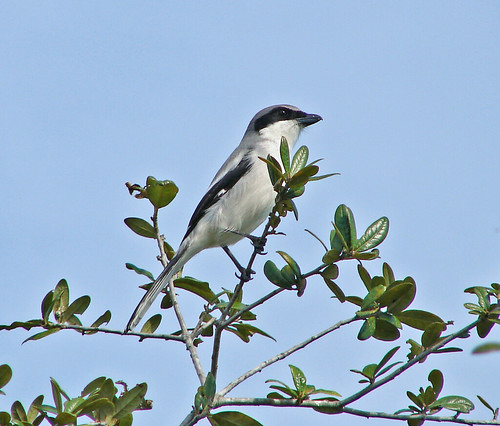 |
| Loggerhead Shrike |
When I bird in Florida, I’m ever scanning fence posts and power lines in hopes of seeing Loggerhead Shrikes.
Shrikes are predacious songbirds, but that’s not very exceptional—so are chickadees, robins, and bluebirds, the insects and worms they eat being very much animals. Shrikes feed on small lizards, birds, and mammals as well as insects, but so do some crows, ravens, and even large flycatchers. The difference is that shrikes eat meat almost exclusively, with physical and behavioral adaptations unique among songbirds. The hooked beak tip and sharp notch near the tip help grab and sever the spinal cord of small vertebrates. When a shrike bites off more than it can chew in one meal, so to speak, it can impale whole prey or parts on thorns or barbed wire, or wedge it into the fork of a branch, both for easier killing and for longer-term storage. This habit led to the family nickname, “butcherbirds.”
The proportionally large head of all shrikes is particularly highlighted in the Loggerhead Shrike’s name, a synonym for “blockhead.” Of the 30 or so species in the family, only the Loggerhead is entirely restricted to North America. It’s a little smaller and daintier than the Northern Shrikes we see up here in winter. And Loggerhead Shrikes eat fewer rodents and birds, focusing heavily on grasshoppers.
 |
| Loggerhead Shrike eating grasshopper |
Loggerhead Shrikes used to be fairly regularly seen in southern Wisconsin and Minnesota, but they declined drastically through the last half of the twentieth century. They’ve essentially vanished from the northeastern part of their range and continue to decline everywhere else. The subspecies on San Clemente Island in California is listed as endangered on the federal list.
 |
Breeding Bird Survey numbers:
Loggerhead Shrike decline in Wisconsin |
 |
Breeding Bird Survey numbers:
Loggerhead Shrike decline in Minnesota |
I’ve visited Florida almost every year since our son Joe moved there in 2003. I have a much harder time finding them now than I used to down there, and the steep decline shown in Breeding Bird Survey numbers for Loggerhead Shrikes in Florida between 1966 and 2010 bears graphic testament to my experience. I find it endlessly frustrating that despite the dramatic decline virtually everywhere, they aren’t on the federal list for endangered, or at least threatened, species.
 |
Breeding Bird Survey numbers:
Loggerhead Shrike decline in Florida |
 |
Breeding Bird Survey numbers:
Loggerhead Shrike decline in United States |
Russ and I had a pretty close encounter with a nesting pair back in 2006. I got plenty of photos, though this was before I had a high quality camera. Because they were nesting in an area with heavy foot traffic and we were quiet and unobtrusive, they pretty much ignored us.
 |
Russ and I watched this breeding Loggerhead Shrike at a Nature Conservancy/Disney
property in Florida in 2005. |
Overall, Loggerhead Shrikes seem a little calmer in the presence of gawking birders than Northern Shrikes usually are, but even they are a bit skittish. In January I came upon one while on a pleasant drive from Titusville to New Smyrna Beach in Florida. It had caught a large grasshopper and was starting to eat it. I stopped momentarily when I spotted it and snapped a few photos from my car window, but I did not want to risk frightening off the little predator, especially since he might have lost the morsel, so I drove on. We humans haven’t left them much space and our pesticides kill many of their prey, but these handsome songbirds deserve our respect and affection.
 |
| Loggerhead Shrike with grasshopper |









